If you’re a bird enthusiast or simply enjoy the sweet sound of nature, Indiana is a paradise for you.
This state is a haven for a variety of bird species that thrive in its diverse landscapes, from lush forests to expansive wetlands.
Whether you’re an avid birder or just starting out, you’ll be captivated by the stunning beauty and unique characteristics of the 17 common birds found in Indiana.
From the striking Indigo Bunting to the majestic Northern Flicker, each bird has its own story to tell, and we’ll take you on a journey to discover them all.
So, get ready to spread your wings and soar through the fascinating world of Indiana’s feathered friends.
| Image | Bird | Features | Price |
|---|---|---|---|
 |
| 9.7 | Check Price |
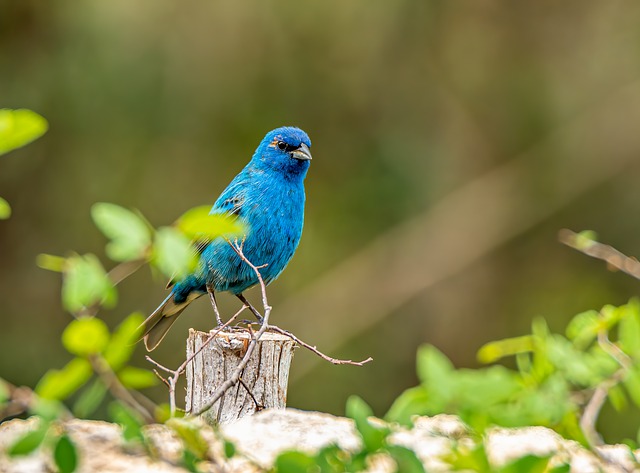 |
| 9.5 | Check Price |
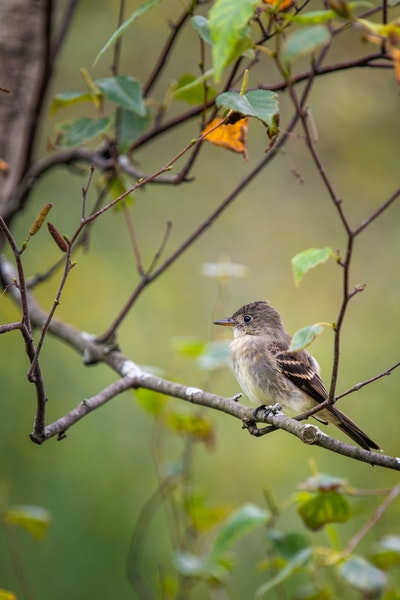 |
| 9.1 | Check Price |
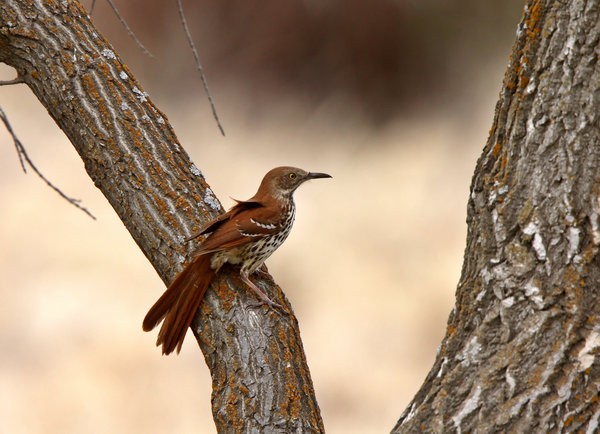 |
| 8.8 | Check Price |
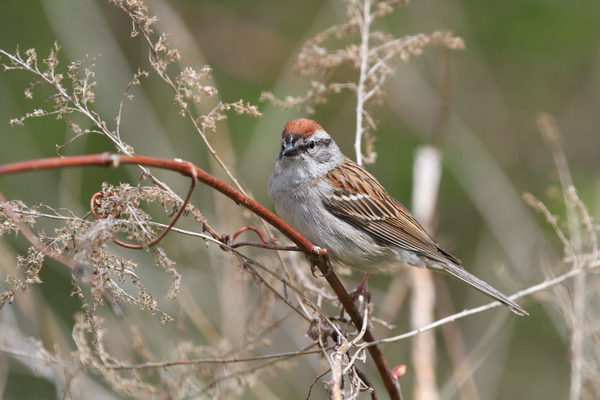 |
| 8.6 | Check Price |
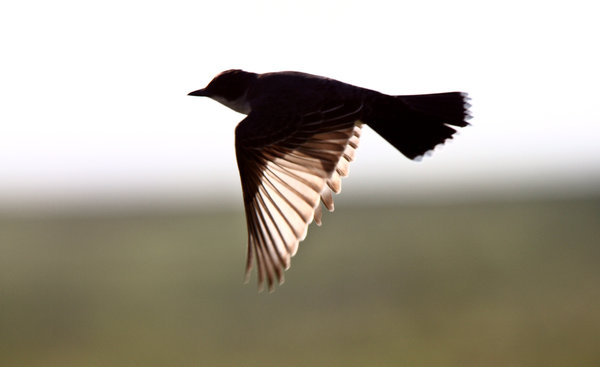 |
| 8.2 | Check Price |
 |
| 8 | Check Price |
 |
| 7.7 | Check Price |
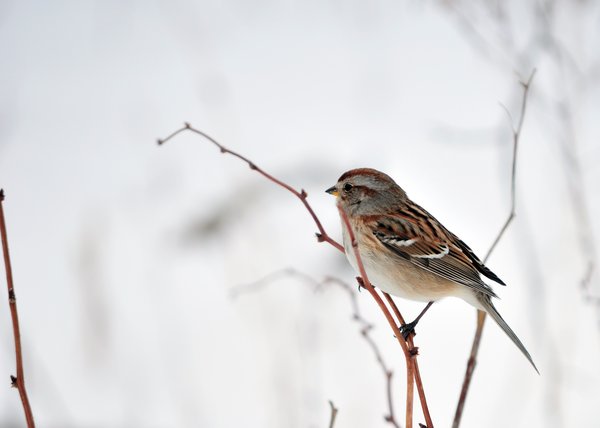 |
| 7.4 | Check Price |
 |
| 7.2 | Check Price |
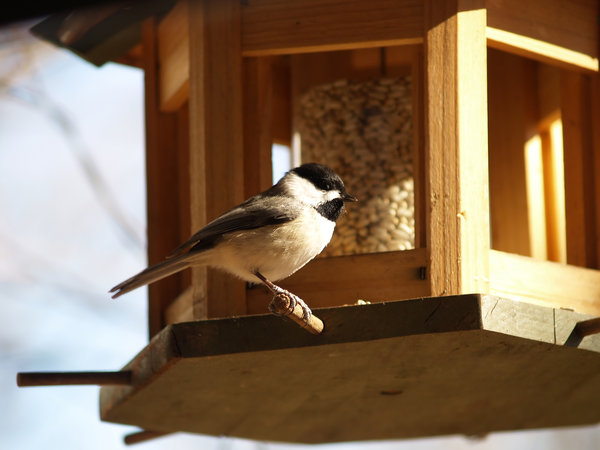 |
| 9.5 | Check Price |
 |
| 9.5 | Check Price |
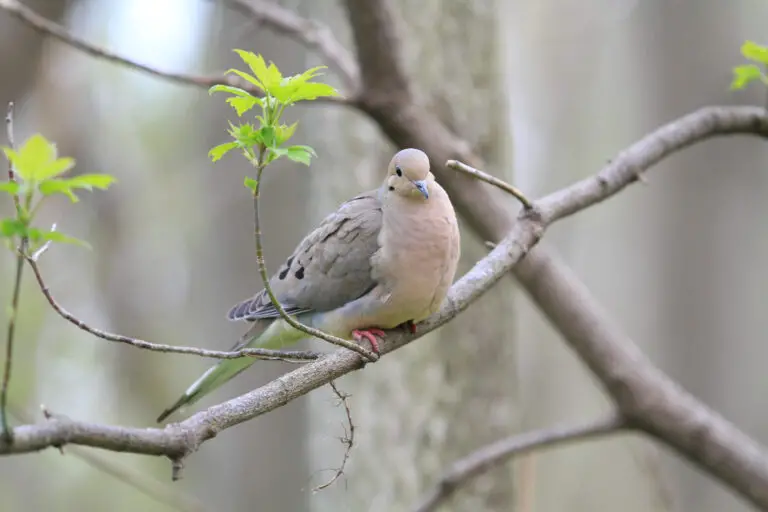 |
| 9.5 | Check Price |
 |
| 9.5 | Check Price |
 |
| 9.5 | Check Price |
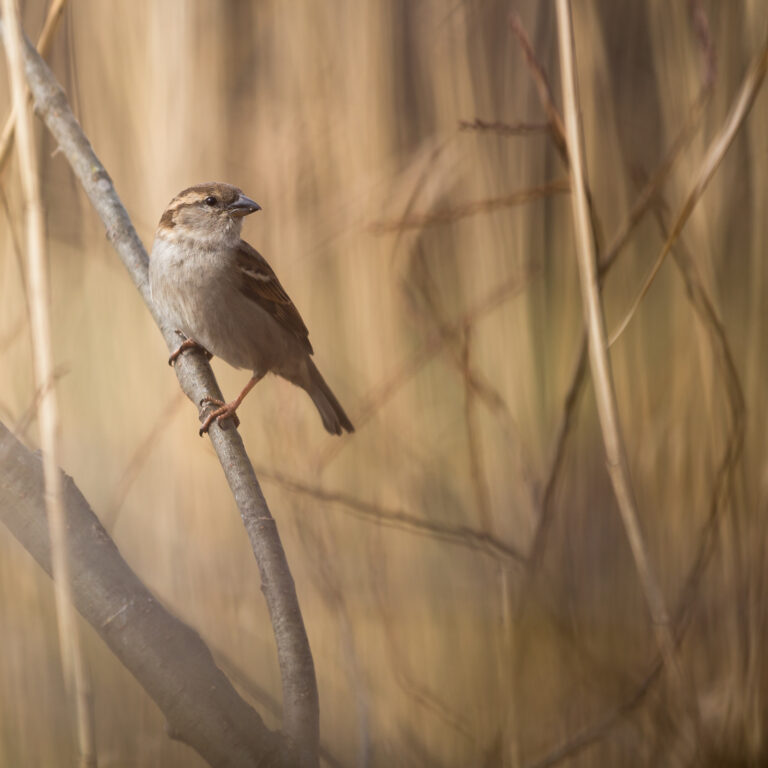 |
| 9.5 | Check Price |
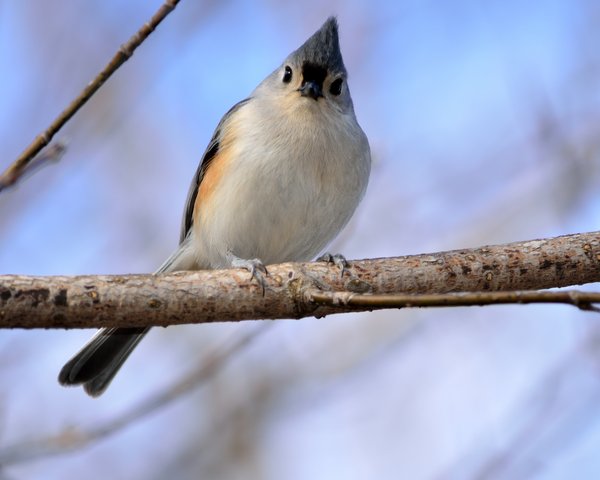 |
| 9.5 | Check Price |
If you don’t have the time to read the whole article, check out this video for a quick understanding.
Common Birds in Indiana
1. American Robin

The American Robin (Turdus migratorius) is a brightly colored Indiana native.
This bird has grey and brown wings and a bright orange belly, with a white patch just under the tail that is easy to spot in flight.
This bird has a graying-black head with a small white ring around the eye, with females being somewhat lighter in color.
These birds have small and curled yellow beaks.
These birds range in length from 7.9 to 11 inches and have wingspans ranging from 12.2 to 15.8 inches.
These birds may be seen in a variety of places, including deciduous trees, pastures, and even bouncing around in the snow in your own yard.
These birds are quite gregarious and do not mind living in the suburbs.
American Robins eat a variety of foods, including peanut pieces, raisins, diced apples, suet, and sunflower seeds.
They are pleasant and simple to please, even when you indicate that mealworms are their preference.
Below are the characteristics of the American Robin,
| Scientific Name | Turdus migratorius |
| Family Name | Turdidae |
| Length | 9-11 inches |
| Weight | 2.7-3 oz |
| Wingspan | 12-16 inches |
| Habitat | Woodlands, parks, gardens, suburban areas |
| Food | Insects, worms, fruits, berries, and sometimes small reptiles or amphibians |
2. Indigo Bunting

Indigo Bunting (Passerina cyanea), often known informally as ‘blue canaries,’ is a vivid azure blue all over their bodies, with some tiny grey accents in their wings.
The hue deepens on the face, and this bird has a silver beak. Females appear extremely different.
They are dark with white streaking on their necks and streaking on their breasts.
These are really something to behold and will stay with you.
These are little birds, averaging 4.7 – 5.1 inches long with wingspans ranging from 7.5 to 8.7 inches.
Look along the forest’s border, particularly where the shrubbery thickens, as you could catch a sight of them foraging in the wild.
Mealworms, Nyjer seeds, and thistle are excellent food sources for these tiny fellows.
Below are the characteristics of the Indigo Bunting,
| Scientific Name | Passerina cyanea |
| Family Name | Cardinalidae |
| Length | 4.3-5.1 inches |
| Weight | 0.4-0.5 oz |
| Wingspan | 7.5-8.7 inches |
| Habitat | Brushy areas, fields, and woodland edges |
| Food | Seeds, insects, and spiders |
3. Eastern Wood-Pewee

Eastern Wood-Pewee (Contopus virens) is olive-gray in color, with darker wings than the rest of their bodies.
They have a yellowish or creamy breast and underbelly that darkens somewhat towards the sides.
These birds have long, pointed beaks that are usually orange on the underside.
The contrast between grey and black makes their eyes look larger.
These birds are about the size of a Sparrow, being around 5.9 inches long and having a wingspan of 9.1 to 10.2 inches.
These birds are most commonly spotted in parks or wooded areas, but if you have a lot of trees in your backyard and hear a distinctive pee-a-wee call, keep a watch out.
They are unique enough to be identified at a glance.
These birds consume flies; you won’t be able to attract them to your feeder if you have a woodlot or if you capture the occasional stray Peewee during the breeding season.
Below are the characteristics of the Eastern Wood-Pewee,
| Scientific Name | Contopus virens |
| Family Name | Tyrannidae |
| Length | 5.5-6.3 inches |
| Weight | 0.3-0.4 oz |
| Wingspan | 9-10 inches |
| Habitat | Deciduous forests, forest edges, and woodlands near water |
| Food | Insects, including flies, beetles, and moths |
4. Brown Thrasher

Brown Thrashers (Toxostoma rufum) have rich brown wings and backs, with black and white wing bars that complement the hue.
Their breast and lower belly portions are white with a strong brown streaking, which makes you question how they can conceal so successfully in the first place.
These birds have brown and grey feathers on their faces. When this is combined with their brilliant yellow eyes and long, pointed black bills, you have a formidable-looking and gorgeous Songbird.
These Songbirds range in size from 9.1 to 11.8 inches, with wingspans ranging from 11.4 to 12.6 inches.
These birds like singing amid the trees at the forest’s edge or just in the woods, as well as heavy vegetation like shrubberies, where they may safely feed behind its protective cover.
These birds can be coaxed out of their protected cover for feeder nibbles, but they prefer thick berry bushes in your yard.
They prefer suet, broken corn, peanuts, and sunflower seeds as feeder foods.
Below are the characteristics of the Brown Thrasher,
| Scientific Name | Toxostoma rufum |
| Family Name | Mimidae |
| Length | 11-12 inches |
| Weight | 2.4-3.1 oz |
| Wingspan | 11-12 inches |
| Habitat | Woodland edges, thickets, and hedgerows |
| Food | Insects, berries, fruits, and seeds |
5. Chipping Sparrow

The breast and bellies of Chipping Sparrow (Spizella passerina) are a combination of white and grey, and they have medium-sized grey tails.
A white face with a grey patch behind the eye and a black stripe running from right behind the eye to the back of the neck distinguishes them.
It has a rusty cap on top of its head and a tiny, straight black bill.
These birds range in size from 4.7 to 5.9 inches in length, with an average wingspan of 8.3 inches.
These birds are mostly found in woodlands, fields, and parks, these birds will happily visit your feeder if you’ve loaded it with foods they enjoy.
They prefer insects but will also eat seeds. Filling your feeder with Nyjer seed, Black Oil sunflower seed, millet, and mealworms might attract this bird.
Below are the characteristics of the Chipping Sparrow,
| Scientific Name | Spizella passerina |
| Family Name | Passerellidae |
| Length | 4.7-5.5 inches |
| Weight | 0.4-0.5 oz |
| Wingspan | 7.5-8.7 inches |
| Habitat | Open woodlands, gardens, and parks |
| Food | Seeds, insects, and spiders |
6. Eastern Kingbird

The Eastern Kingbird (Tyrannus tyrannus) appears to be a sassy bird.
The wings of this bird are gray-black, and the tail is tipped in a fashionable white.
The breast and belly are all white, and the impression is perfectly completed by the bird’s head.
First, the white from the breast spreads to the face, where it comes to a halt beneath its straight, pointed black bill.
Second, its face is mostly black, and it’s a darker shade of black than its wings. It looks like a small bird dressed up in a suit!
This bird measures 7.5–9.1 inches in length and has a 13–15 inch wingspan.
These birds spend the winter in South America; they prefer to visit a variety of locales.
They can be found in fields, woodland margins, and even marshlands.
Such as the Eastern Wood Peewee, this bird is a flycatcher, but it also eats a variety of other foods.
Berry plants in your yard, especially if you have a lot of trees, may tempt them.
Below are the characteristics of the Eastern Kingbird,
| Scientific Name | Tyrannus tyrannus |
| Family Name | Tyrannidae |
| Length | 7.5-8.7 inches |
| Weight | 1.2-1.8 oz |
| Wingspan | 13-15 inches |
| Habitat | Open fields, farmlands, and pastures |
| Food | Insects, including bees, wasps, and grasshoppers |
7. Northern Flicker

Northern Flicker (Colaptes auratus) features grey wings with black patterning and white breasts with black spotting, as well as a broad black necklace stripe.
This bird is distinguished from the Eastern variety by the presence of yellow at the tail ends, whilst the Western has a red tail tip.
Their crowns are blue and grey, with tan cheeks and a red spot on the back of the neck.
Males have a mustache mark on their long, thin bills that reach back.
The Northern Flicker is a medium-sized bird, measuring 11–12.2 inches from tip to tail and with a wingspan of 16.5–20 inches.
These birds are commonly seen in parks, backyards, and at the border of forests.
They like to search for insects on the ground, so gaze down rather than above.
You might be able to attract a Northern Flicker to your suet feeder if it supports an enlarged tail tip.
Below are the characteristics of the Northern Flicker,
| Scientific Name | Colaptes auratus |
| Family Name | Picidae |
| Length | 11-12 inches |
| Weight | 3.9-5.6 oz |
| Wingspan | 16-20 inches |
| Habitat | Open woodlands, parks, and suburban areas |
| Food | Insects, fruits, seeds, and occasionally small animals |
8. Snow Bunting

Snow Bunting is quite easy to recognize, however, there will be differences depending on their gender and whether or not they are breeding.
Males are totally white except for their black backs.
Females, on the other hand, will have brown streaks evident on their back and the rest of their body will be the same white as the male.
Outside of the breeding season, females will have rusty-red spots on their faces and breasts, while males will have rusty patches on their breasts, a unique reddish ‘ear spot,’ and a rusted crown.
The Snow Bunting has a wingspan of 11.8 inches and measures 5.9 inches from tip to tail.
These birds prefer grasslands and are lured to water. Considering their protection, they choose to nest in rocky locations.
Mealworms are the preferred food of these birds, although they also enjoy Nyjer seed and Thistle.
Below are the characteristics of the Snow Bunting,
| Scientific Name | Plectrophenax nivalis |
| Family Name | Calcariidae |
| Length | 5.5-7 inches |
| Weight | 1-1.4 oz |
| Wingspan | 12-14 inches |
| Habitat | Tundra, rocky areas, and shorelines |
| Food | Seeds and insects |
9. American Tree Sparrow

American Tree Sparrows (Spizelloides arborea) have grey wings with heavy brown streaks and white accents on the shoulder.
The breast is often a light grey or brown hue, with a black blotch, while the underside is slightly lighter in color.
With grey heads, rust-colored caps, and a rust’ mask’ enclosing the eye and extending almost to the end of the neck, these birds have long tails and very unusual facial coloration.
They have short, muscular beaks that are half yellow and half grey or black.
With wingspans of roughly 9.4 inches and an average length of 5.5 inches, these birds are petite.
These birds like woodland edges, bushes, and fields, and they are occasionally drawn to water.
They enjoy visiting feeders as well, but they prefer to go in small groups.
Mealworms and dried berries are the keys to these birds’ hearts, so stock up and watch who shows up.
Below are the characteristics of the American Tree Sparrow,
| Scientific Name | Spizelloides arborea |
| Family Name | Passerellidae |
| Length | 4.7-5.9 inches |
| Weight | 0.4-0.6 oz |
| Wingspan | 7.9-9.4 inches |
| Habitat | Tundra, boreal forests, and shrubby areas |
| Food | Seeds, insects, and fruits |
10. Cedar Waxwing

Spotting these birds is a tremendous treat. The Cedar Waxwing (Bombycilla cedrorum) has highly striking markings, including grey wings with little red points and grey tails with yellow ends.
The underbelly has a faint but noticeable yellow tint, but the chest and head are dark brown.
The brown coloring on the face is almost like a lion’s mane, and the image is completed by a lovely mask nicely defined in white.
Their beaks are short, dark, and thick.
Cedar Waxwings range in size from 5.5 to 6.7 inches in length, with wingspans ranging from 8.7 to 11.8 inches.
These birds prefer Evergreen trees and are fascinated by water.
They are extremely fond of fruit-filled gardens, so if you have one, you may encounter one of these magnificent birds.
Fruits are an excellent method to attract a Waxwing to your feeder, but you must also make the bird feel secure.
They are rather timid, so leave out a variety of sliced apples, grapes, and raisins if you’ve noticed one close and want to host as a guest.
Below are the characteristics of the Cedar Waxwing,
| Scientific Name | Bombycilla cedrorum |
| Family Name | Bombycillidae |
| Length | 5.5-6.5 inches |
| Weight | 1.1 oz |
| Wingspan | 8.7-11 inches |
| Habitat | Woodlands, orchards, and suburban areas |
| Food | Fruits, berries, and insects |
11. Carolina Chickadee

Carolina Chickadee is a lovely tiny bird having light grey wings with the grey darkening down the wings and all the way to its tail.
Their underbelly and breasts are a gorgeous powder white that reaches all the way to the base of the throat.
This bird has a big black cap that spans over its entire face, level with the center of its eye.
The bird is white below until the area under its bill when the black on its throat curls down to provide a lovely impression.
The Carolina Chickadee is a little bird with a wingspan of 5.9 to 7.9 inches and a length of 3.9 to 4.7 inches.
These birds can be found in forests, parks, and even backyards.
Suet, crushed peanuts, and Black Oil sunflower seeds are an excellent combination for luring these delicate creatures.
Below are the characteristics of the Carolina Chickadee,
| Scientific Name | Poecile carolinensis |
| Family Name | Paridae |
| Length | 4-5 inches |
| Weight | 0.3-0.4 oz |
| Wingspan | 6.3-8.7 inches |
| Habitat | Deciduous forests, parks, and suburban areas |
| Food | Insects, spiders, and seeds |
12. Purple Finch
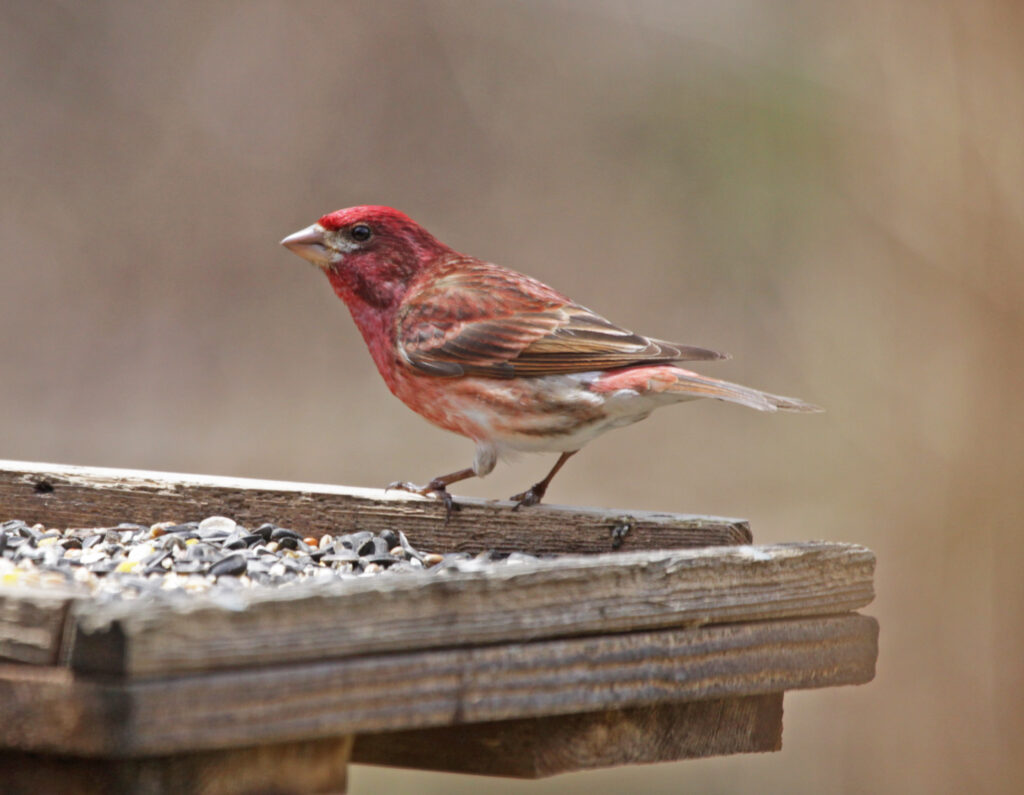
Every now and then, you get a visit from a genuine beauty, and the Purple Finch (Haemorhous purpureus) is one of them.
Males have dark brown and raspberry-streaked wings, and their white breasts are lighter raspberry-streaked.
Their faces are raspberry-red, with a lighter-colored eye stripe and a black line visible on their necks.
Their beaks are powerful and bright, with a little black accent on occasion.
Females lack the red color but have the same patterns, but in a lighter brown to tan hue.
These birds prefer coniferous woods, although they also like bushes, pastures, and even backyards.
If you have a garden with berry vines, this is one technique to attract a Purple Finch.
If you don’t have any, these birds love Black Oil Sunflower seeds and will gladly eat from your feeder if you leave some out for them.
Below are the characteristics of the Purple Finch,
| Scientific Name | Haemorhous purpureus |
| Family Name | Fringillidae |
| Length | 5.5-6 inches |
| Weight | 0.8-1 oz |
| Wingspan | 9-10 inches |
| Habitat | Coniferous and mixed forests, and suburban areas |
| Food | Seeds, buds, and insects |
13. Mourning Dove
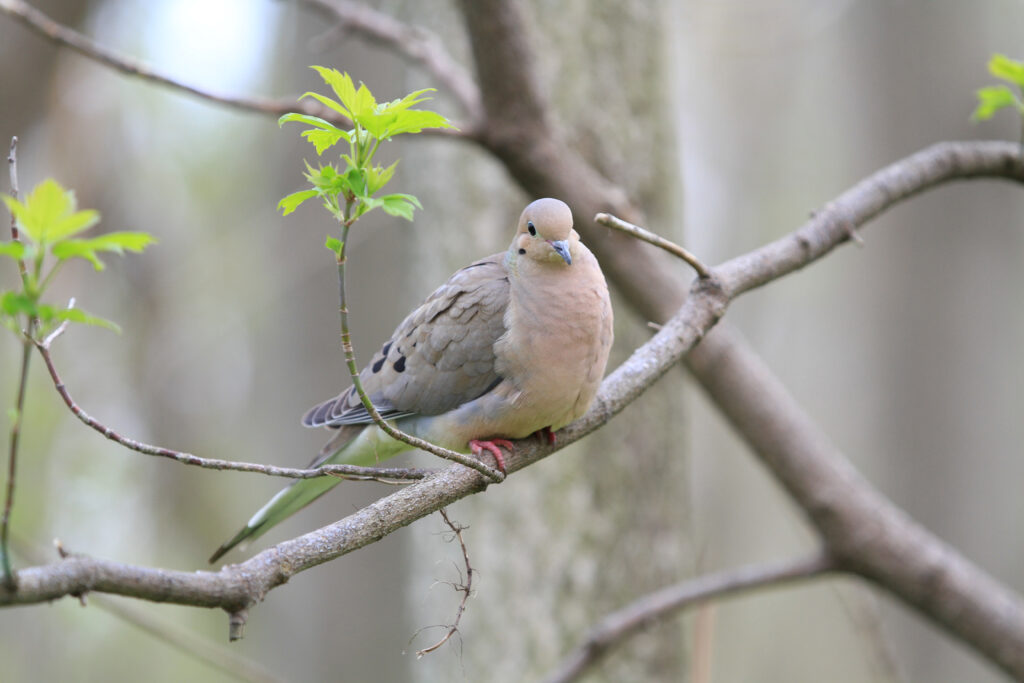
Mourning Doves (Zenaida macroura) have a tan over extremely light brown, occasionally with a grey mix coloration all over their body.
As one may observe, it’s a delicate mix, with some distinguishing features like the wings being darker than the breast, underside, and head, and this Dove having spots on its wings and white tips on its tiny tail.
They have delicate black bills quite little and delicate.
The Mourning Dove has a wingspan of roughly 17.7 inches and a body length of 9.1 – 13.4 inches.
These birds like to build their nests in Evergreen trees or dense shrubbery, but you’ll often see them hopping around on the ground or on a telephone pole scouting the area before eating.
For optimal results to gather these birds, scatter some seeds around your feeder.
If you don’t like the ground technique, try millet or sunflower seeds.
You can also grab their attention by feeding hangers if you don’t like millet or sunflower seeds.
Below are the characteristics of the Mourning Dove,
| Scientific Name | Zenaida macroura |
| Family Name | Columbidae |
| Length | 9-13 inches |
| Weight | 4-6 oz |
| Wingspan | 17-19 inches |
| Habitat | Open fields, urban areas, and woodlands |
| Food | Seeds and grains |
14. White-breasted Nuthatch

White-breasted Nuthatch has blue and grey wings and tails with black accents, as well as a white breast and underbelly.
The underbelly is typically patterned with a distinctive brown pattern, while the underside of the tail is white.
These birds have a white face and neck, as well as some white on the underside of the bill, which is black at the tip and connects to a grey or black cap that extends all the way back to the wings.
The bill is long and straight, with a faint black line going from the back of the eye and gradually decreasing in color as it approaches the cap.
These birds are about the size of a sparrow, measuring 5.1 – 5.5 inches long with wingspans ranging from 7.9 to 10.6 inches.
They are frequent visitors to the woods and woodland edges, and they are particularly fond of Oak trees and their delectable acorns.
Suet, sunflower seeds, and peanuts will assist to entice the White-breasted Nuthatch to pay you a visit, and if you’re lucky, they could become return visitors.
Below are the characteristics of the White-breasted Nuthatch,
| Scientific Name | Sitta carolinensis |
| Family Name | Sittidae |
| Length | 5.5-6 inches |
| Weight | 0.6-1 oz |
| Wingspan | 8.5-10 inches |
| Habitat | Deciduous and mixed forests, and suburban areas |
| Food | Insects, seeds, and nuts |
15. Downy Woodpecker

Woodpeckers are popular among birdwatchers for good reason. They are rarely bashful and appear to be well-educated. One of them is the cute Downy Woodpecker (Dryobates pubescens).
These tiny fellows have black wings with white patterning, giving them a striking checkered appearance that catches your eye.
They feature a large white stripe across their back, as well as a solid white breast and underbelly.
They have concentrated faces, with white faces and a mustache line running from the bill, as well as a black mask that reaches to the back of the neck.
A black center stripe runs across the top of the head, terminating in a gorgeous red patch on the males and white on the females.
These birds have short black beaks and short black tails with white undersides, giving them a gorgeous look.
The Downy is a tiny Woodpecker, measuring 5.5 – 6.7 inches in length and 9.8 to 11.8 inches in wingspan.
They love deciduous forests, although they may also be found in parks and backyards with a few trees for companionship.
Peanuts and peanut butter, as well as Black Oil Sunflower seeds, are a good way to tempt these small creatures.
Below are the characteristics of the Downy Woodpecker,
| Scientific Name | Dryobates pubescens |
| Family Name | Picidae |
| Length | 5.5-6.5 inches |
| Weight | 0.7-1 oz |
| Wingspan | 9.5-11 inches |
| Habitat | Deciduous and mixed forests, and suburban areas |
| Food | Insects, fruits, and seeds |
16. House Sparrow
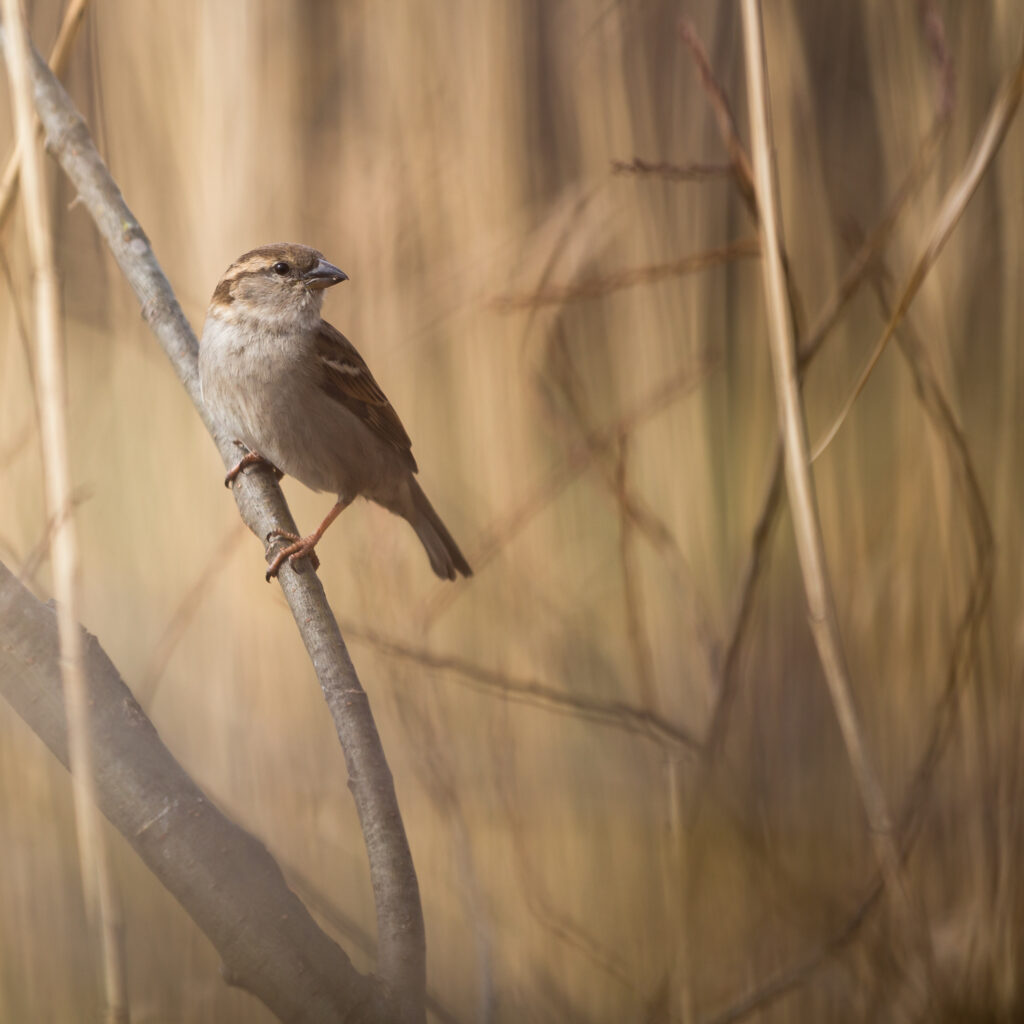
House Sparrows (Passer domesticus), like many other birds, show color variations between sexes.
House Sparrows feature brown and black wing striping on both males and females, although males have a more colorful overall color.
Their breast and underside are grey and white, with a unique black bib that runs facially up to the lower bill, and white cheeks that contrast starkly.
Apart from the checks, their heads are mostly a lovely brown with a scattering of grey on top. It’s a lovely contrast.
Females are predominantly brown, with grey and brown patches on their breasts and underbelly.
These birds have robust, slightly curved black beaks and perky tails.
These birds are 5.9 – 6.7 inches in length and have wingspans ranging from 7.5 to 9.8 inches in length.
They are usually found around buildings and will cheerfully visit your garden or feeder for tasty nibbles.
These birds eat a variety of seeds. Simply adding sunflower seeds and maize would be enough, however, these birds will most likely visit even if you do not have a feeder.
They are at ease in our surroundings, making these lovely tiny birds simple to see if you look.
Below are the characteristics of the House Sparrow,
| Scientific Name | Passer domesticus |
| Family Name | Passeridae |
| Length | 5.5-6.5 inches |
| Weight | 1-1.5 oz |
| Wingspan | 7.5-9.5 inches |
| Habitat | Urban and suburban areas |
| Food | Seeds, insects, and human food scraps |
17. Tufted Titmouse

The Tufted Titmouse (Baeolophus bicolor) is a lovely little bird that proves that color does not have to be complicated to be appealing.
Their wings are a light blue-grey that contrasts beautifully with the white breast and lower belly, which has some peach coloration splashed in at the belly area.
With one exception, they have a little blue crest that extends to the rear of the neck and frames the rest of the white face.
This bird has a noticeable black patch on its thin, curved beak, as well as large, black eyes.
This bird is 5.5 – 6.3 inches long with a wingspan of 7.9 to 10.2 inches.
These birds enjoy evergreen woodlands, but they are also at home in the suburbs, visiting backyard feeders and gardens with gusto.
These birds prefer Suet, however, Black Oil sunflower seeds are a favorite that they will happily sup and munch on.
Below are the characteristics of the Tufted Titmouse,
| Scientific Name | Baeolophus bicolor |
| Family Name | Paridae |
| Length | 5.5-6 inches |
| Weight | 0.5-0.7 oz |
| Wingspan | 7-8 inches |
| Habitat | Deciduous and mixed forests, and suburban areas |
| Food | Insects, seeds, and nuts |
Conclusion
In conclusion, Indiana is a remarkable place to observe a variety of bird species.
Whether you’re exploring the urban areas or venturing into the wilderness, you’re bound to spot some of the most stunning and fascinating birds in the state.
From the vibrant American Robin to the impressive Mourning Dove, each bird has its unique characteristics and adds to the beauty of Indiana’s natural environment.
With their captivating beauty, melodic songs, and remarkable behaviors, birds have an important role in our ecosystem, and observing them is a delightful experience that can enrich our lives.
So, grab your binoculars, head out into the field, and start exploring the fascinating world of Indiana’s feathered residents.
FAQ
What is the state bird of Indiana?
The state bird of Indiana is the Northern Cardinal, a popular songbird with vibrant red feathers and a distinctive crest.
What other songbirds can be found in Indiana?
Indiana is home to a wide variety of songbirds, including the American Goldfinch, Eastern Bluebird, Indigo Bunting, and Tufted Titmouse.
What are some of the waterbirds that can be seen in Indiana?
Indiana is home to several waterbirds, including the Great Blue Heron, Double-crested Cormorant, and Wood Duck.
Are there any birds of prey in Indiana?
Yes, Indiana is home to several species of birds of prey, including the Bald Eagle, Red-tailed Hawk, Cooper’s Hawk, and American Kestrel.
When is the best time to go birdwatching in Indiana?
The best time to go birdwatching in Indiana is in the spring and fall when many bird species are migrating. However, there are also plenty of resident birds to see year-round.
Are there any endangered bird species in Indiana?
Yes, there are several endangered bird species in Indiana, including the Kirtland’s Warbler, Henslow’s Sparrow, and Indiana Bat. It’s important to observe birds from a safe distance and not disturb their habitats to help protect these vulnerable species.
Last Updated on March 22, 2023 by Lily Aldrin
